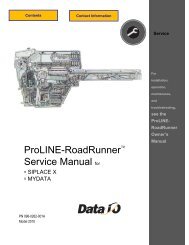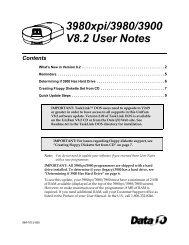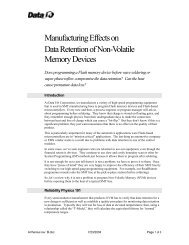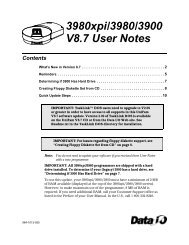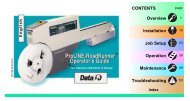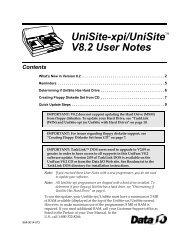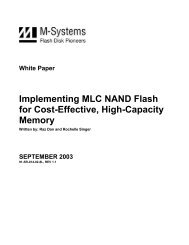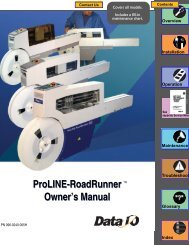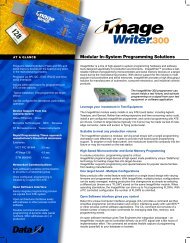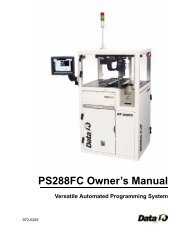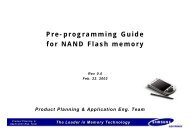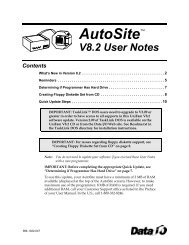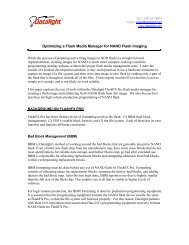3980xpi Users Manual - Data I/O Corporation
3980xpi Users Manual - Data I/O Corporation
3980xpi Users Manual - Data I/O Corporation
You also want an ePaper? Increase the reach of your titles
YUMPU automatically turns print PDFs into web optimized ePapers that Google loves.
CRC Commands<br />
Description Setting<br />
Serial set auto-increment mode No<br />
Programming mode single device<br />
Total set size 1<br />
Upload EOF delimiter flag Disabled<br />
Download EOF delimiter flag Disabled<br />
Computer Remote Control<br />
If you exit remote mode using the Z command, the programmer's parameters<br />
are set to what they were before you entered remote mode. If you exit using<br />
CTRL + Z, the programmer's parameters are NOT changed.<br />
CRC commands are simplified commands for the programmer that are<br />
designed to be received from a controlling computer. Because the commands<br />
are so simplified, they can be cryptic at times.<br />
CRC Command Summary<br />
You send CRC commands to the programmer by typing the command and then<br />
pressing the ENTER key. When the programmer receives a CRC command, the<br />
command is executed and a response is sent back, followed by a carriage<br />
return. If the response is an F, an error occurred. If the response is a ?, the<br />
programmer did not understand the command. If the response is a >, the<br />
normal CRC prompt, the command executed properly. Some commands<br />
respond with both a value and the prompt. For example, the programmer<br />
might return 00284295> when you send the Calculate Sumcheck command. In<br />
this case, the 00284295 is the sumcheck and the > indicates that the command<br />
executed properly. The I, O, and C commands perform any data transfer prior<br />
to sending the response.<br />
Each command in the CRC command set is summarized in the following tables.<br />
For a more detailed explanation of CRC commands, refer to the “UniSystem<br />
Computer Remote Control” Application Note (983-0490) available from<br />
Customer Support. The command tables are broken up into standard and<br />
extended CRC commands. Standard CRC commands are commonly used<br />
commands, such as Load, Program, and Verify. Extended CRC commands are<br />
more specific device-related commands, such as Set Security Fuse, Fill Fuse<br />
Map, and Set Vector Test Options.<br />
Note: While in CRC mode, the programmer recognizes only<br />
uppercase characters.<br />
Except where noted, the commands use the following notation conventions:<br />
� lower-case alphabetic characters indicate arguments that must be specified<br />
� h represents a hexadecimal digit.<br />
� n represents a decimal digit.<br />
� xxx...xxxx represents a string of characters. Filenames are limited to 12<br />
total characters: name (eight characters), a period (one character), and an<br />
extension (three characters).<br />
For example, nn02] indicates that you may precede the 02] command with<br />
two decimal digits.<br />
<strong>3980xpi</strong>/3980/3900/2900 User <strong>Manual</strong> B-5




